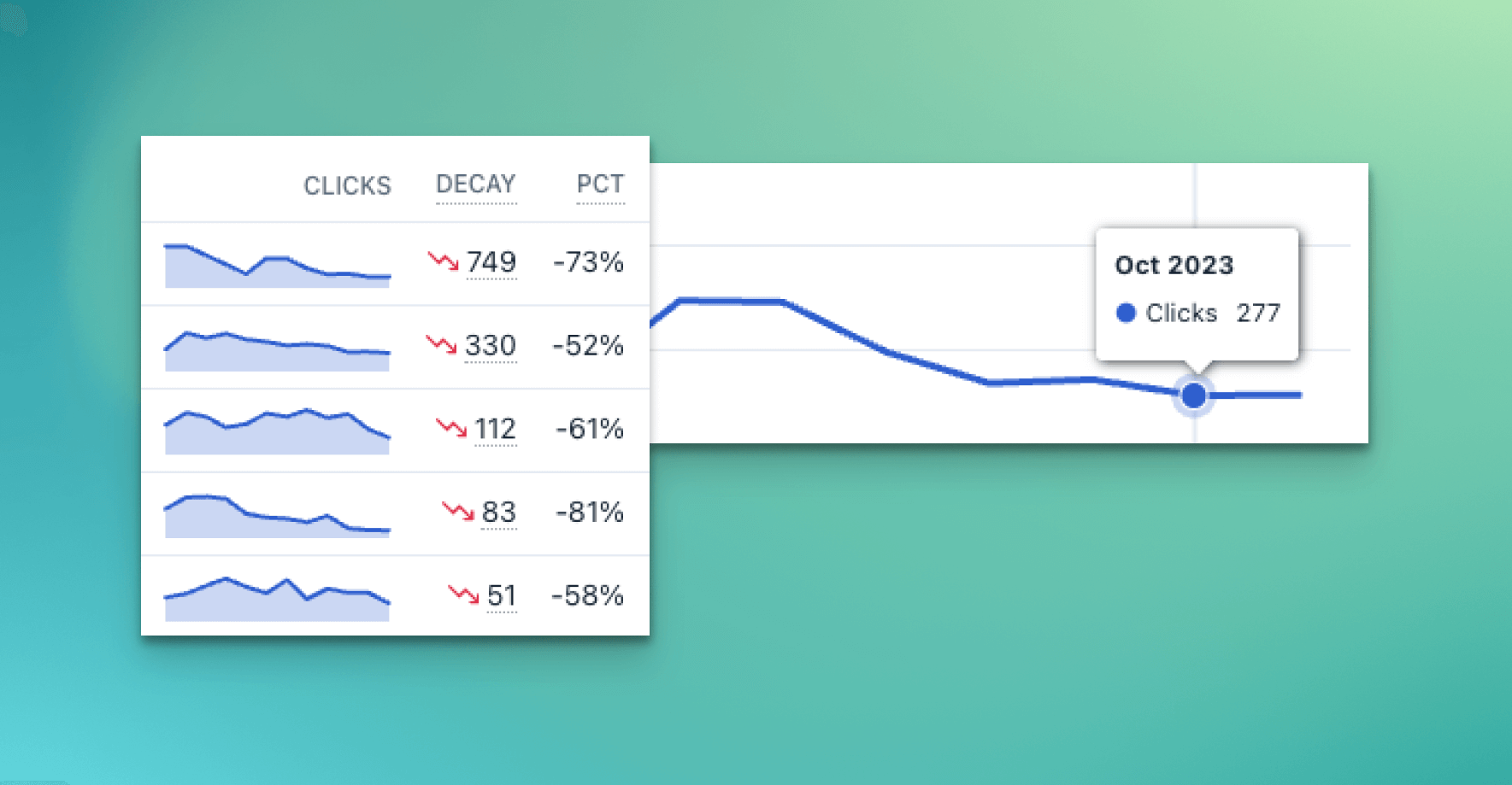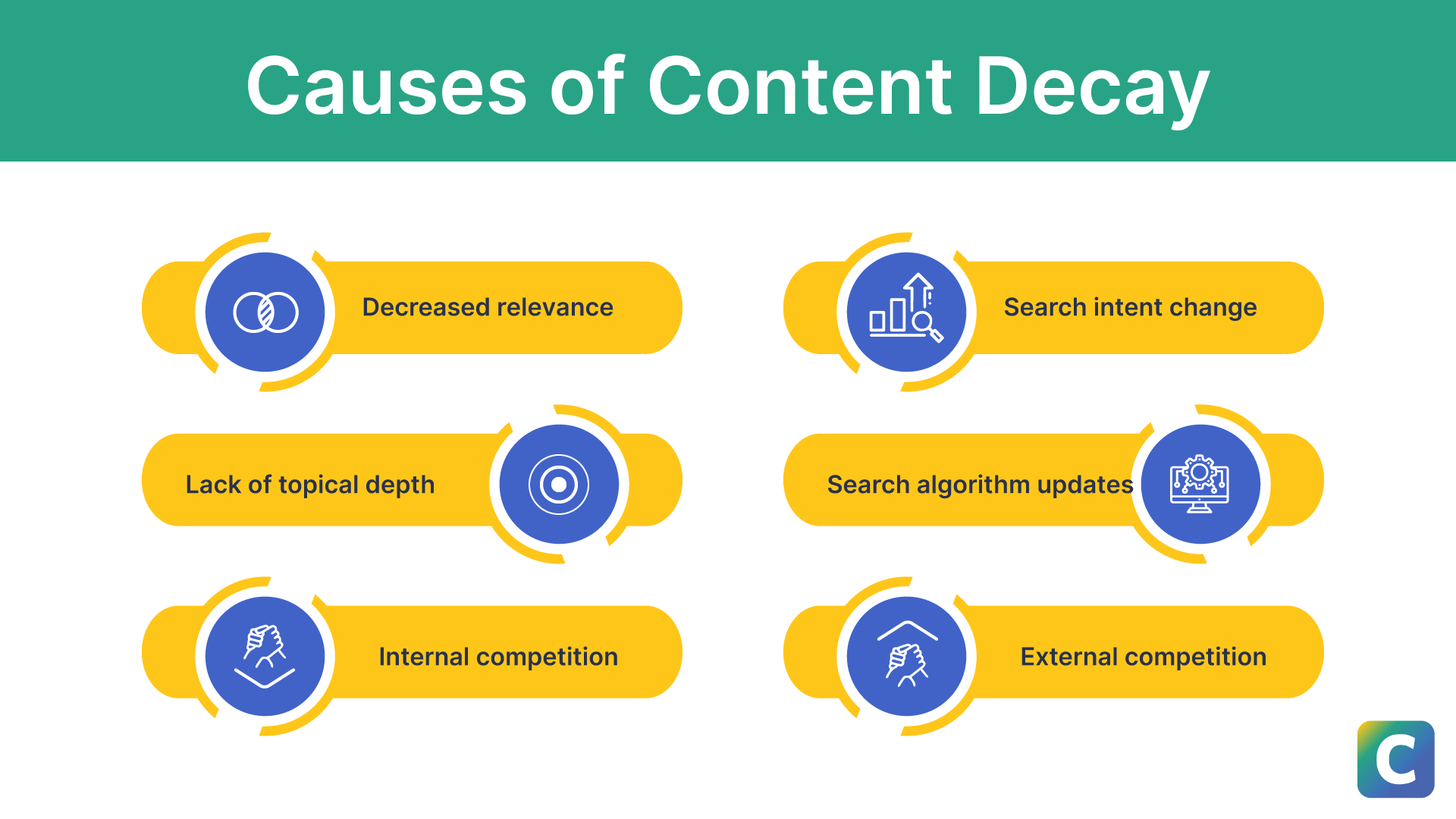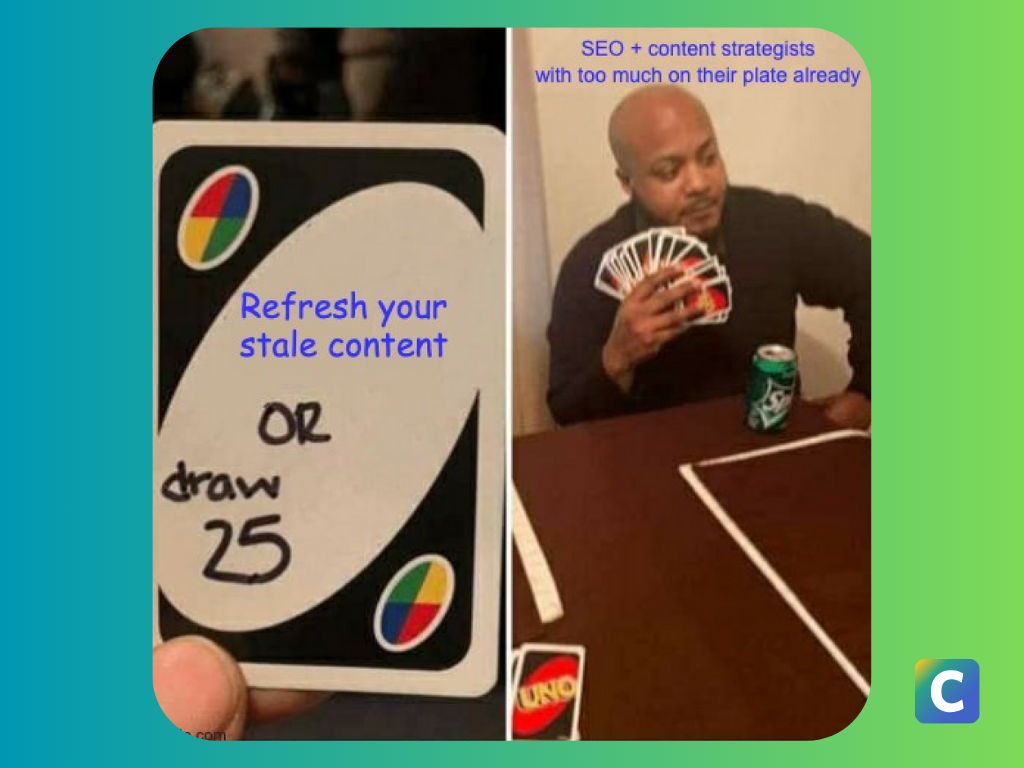What Is Content Decay and Why It Matters for SEO
Topic: Content Marketing
Published:
Written by: Bernard Huang
TL;DR: What Is Content Decay?
Content decay refers to the gradual decline in the performance and relevance of a piece of content over time.
This phenomenon impacts a website's SEO content, leading to lower rankings, decreased organic traffic, and diminished conversions.
Addressing content decay is essential for maintaining strong SEO performance and overall website health.
In this Clearscope webinar, Nate Turner from Tenspeed addresses what content decay is and the processes and systems you need in place to fix it.
Why Content Decay Matters for SEO
Content decay is a significant concern for SEO because it directly affects a website's visibility on search engine results pages (SERPs).
As content decays, it loses its ability to rank well, resulting in lower rankings and less traffic.
Content decay affects:
Search engine rankings and visibility in the SERPs
User experience
CTR and search intent
Performance as search engine algorithms change
Search Engine Rankings
When content starts to decay, it slips down the search engine results pages (SERPs), making it less likely to be discovered by users.
This decline in rankings can be due to various factors, including outdated information, increased competition, and changes in search engine algorithms.
User Experience
Outdated content can negatively impact user experience.
If visitors find that the information on your site is no longer relevant or accurate, they are less likely to engage with your content or return to your site, increasing the bounce rate.
For example: If you still talk about the pandemic lockdown in your content in present tense, this can reduce trust in freshness and relevancy of your content. Users are clued in that you do not regularly update outdated information.
Search Intent and Click-Through Rates (CTR)
Content that no longer aligns with current search intent can suffer from decreased CTR.
As search intent evolves, so must the content to meet the needs and expectations of searchers.
Search Engine Algorithms and Google Updates
Search engines like Google constantly update their algorithms to provide users with the most relevant and high-quality content.
Content decay can result in lower rankings as algorithms prioritize fresher and more accurate content.
How Does Content Decay Happen?
Understanding how content decay occurs in your existing content can help you develop strategies to combat it effectively and stay on top of organic search rankings.
The Lifecycle of a Piece of Content
Every piece of content goes through a “content lifecycle,” which starts at its creation.
Initially, new content attracts attention, ranks well, and drives traffic. Each new piece experiences an initial growth phase and then its eventual decline as the page content ages.
But over time, its performance may plateau and eventually decline as it becomes outdated or less relevant to the target search intent.
4 Stages of Content Decay
1. Initial Growth: Fresh content receives high engagement and traffic.
2. Plateau: Traffic and engagement stabilize.
3. Gradual Decline: Performance metrics such as rankings, CTR, and form opt-ins or conversions start to decrease.
4. Significant Decay: Content loses visibility and effectiveness.

Click graphs from Clearscope Content Decay reports that indicate a decay in a tracked page.
Metrics to Track
To identify and address content decay, monitor these metrics in Google Analytics and Google Search Console:
Organic traffic
Engagement rates (previously known as bounce rate)
Average session duration
Click-through rates (CTR)
Rankings for target keywords
Impressions
If you’re a Clearscope user, you’ll also want to monitor your content grade for your target search intent. If your grade drops, you’ll know if you need to refresh.
Signs of Content Decay
Say you have a top-performing blog post that initially ranked on the first page of Google and drove significant traffic.
Over time, newer content from competitors might push it down the rankings, resulting in less traffic and engagement.
Identifying the signs of content decay early can help you take proactive measures.
Look out for:
Decreasing organic traffic
Lower rankings for target keywords
Reduced CTR
Higher bounce rate or lower engagement metrics
Decline in conversions
Causes of Content Decay
Several factors contribute to content decay, including:
Outdated information
Increased competition
Lack of topical depth
Changes in search engine algorithms
Shifts in user intent
Broken links

Additional causes of content decay.
Best Practices for Combating Content Decay
To fix content decay, you’ll need a strategic approach.
But here are some of our favorite best practices:
Conduct a thorough Content Audit
Regularly review your content to identify pieces that are underperforming or outdated.
Tools like Clearscope, SEMrush, and Ahrefs can help analyze content performance and identify areas for improvement.
Identify and Update Outdated Content
Update old content with new data (ie, information gain), fresh perspectives, and important keywords to maintain its relevance. Increase topical depth by covering the subject comprehensively and answering common questions.
Ensure the content aligns with current search intent and user expectations.
A content update can include adding more in-depth information, increasing or decreasing the word count, or re-ensuring it meets the target audience's needs.
Redistribution: Optimizing and Re-promoting Older Content
Re-promote updated content through social media, email marketing, and newsletters to regain traffic and engagement.
Fix Broken Links
Fix broken links and redirect outdated URLs to relevant, updated content to improve user experience and SEO.
Use Tools for Analysis
Leverage SEO tools like Clearscope, SEMrush, and Ahrefs to research competing content pieces, track content performance, identify decaying content, and find opportunities for optimization.
Conducting thorough analysis is essential for knowing what actions to take to maintain search visibility.
Clearscope has an easy-to-understand Content Decay reporting feature that makes this step simpler than ever. Learn more here.
Add New Keywords and Updating Meta Descriptions
While SEO is more than keywords used, it can be important to incorporate new keywords that reflect current search trends and update meta data to improve CTR and rankings.
Enhance Visuals
Improve content by adding infographics, videos, and images.
In addition to refreshing the body of the content, optimize older content by updating meta descriptions, titles, and enhancing visuals.
Ensure High-Quality and Fresh Content Regularly
Consistently publish high-quality, fresh content to stay relevant and meet user expectations. Regularly update your site to prevent publishing lapses or preventing content from becoming outdated.

Monitoring and Maintenance
Regularly check your content to keep it updated and relevant. Google algorithm updates are a significant factor in how content ranks.
Pay attention to search engine algorithm changes and use reporting rhythms to monitor performance and make adjustments as needed.
Internal Competition and Backlinks
Addressing internal competition (also called keyword cannabalization or content cannabalization) and building quality backlinks can also help mitigate content decay.
Ensure your content pieces are not competing against each other for the same keywords.
Follow Case Studies and Examples
Study successful content refreshes from other websites or industry leaders to learn effective strategies for combating content decay. Apply these insights to your own content marketing strategy.
LEARN MORE: Keep up with search trends—and what you need to do about them—with our industry-famous Clearscope Webinar Series.
For example, a regularly published podcast that consistently updates its online content might notice improved website traffic and engagement and discoverability by new listeners.
FAQs about Content Decay
How Does Content Decay Impact Rankings, Organic Traffic, and Conversions?
Content decay can lead to lower rankings, reduced organic traffic, and fewer conversions as outdated content becomes less relevant to searchers and search engines.
How Do You Resolve Content Decay as Part of Your SEO Strategy and Content Marketing Strategy?
Regular content monitoring, content audits, refreshes and re-optimizations, and re-promotions are essential for combating content decay.
Integrate these practices into your overall SEO and content marketing strategy to maintain content performance.
What’s the Difference Between Content Decay and Content Optimization?
Content decay refers to the decline in content performance over time, while content optimization involves improving content to enhance its relevance, quality, and rankings.
Does Internal Linking Help Resolve Content Decay?
Yes, internal linking can help distribute link equity (aka, “link juice”) and traffic across your site, supporting underperforming content and possibly improving its SEO performance.
Additional Resources and Citations
For further reading on combating content decay and enhancing your SEO strategy, check out these resources:
Why Search Intent Optimization Beats Keyword Optimization
Optimizing for search intent vs. SEO keywords: Which is better? Explore the difference between keyword and intent-based SEO strategies.
Read moreClearscope vs MarketMuse vs Surfer: A Detailed Comparison
Clearscope vs MarketMuse vs Surfer: learn the difference between these three content optimization tools and which one will give you a better edge.
Read moreHow to Create a Content Inventory & Perform a Content Audit
Our post explains how to perform a content inventory, audit your existing website content, and maintain an SEO-optimized site — in four simple steps.
Read more